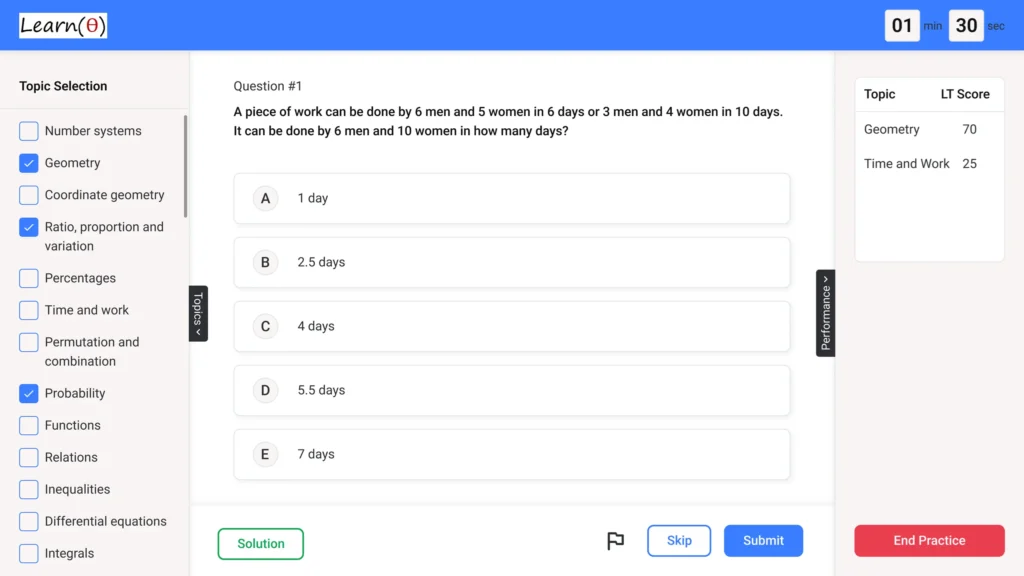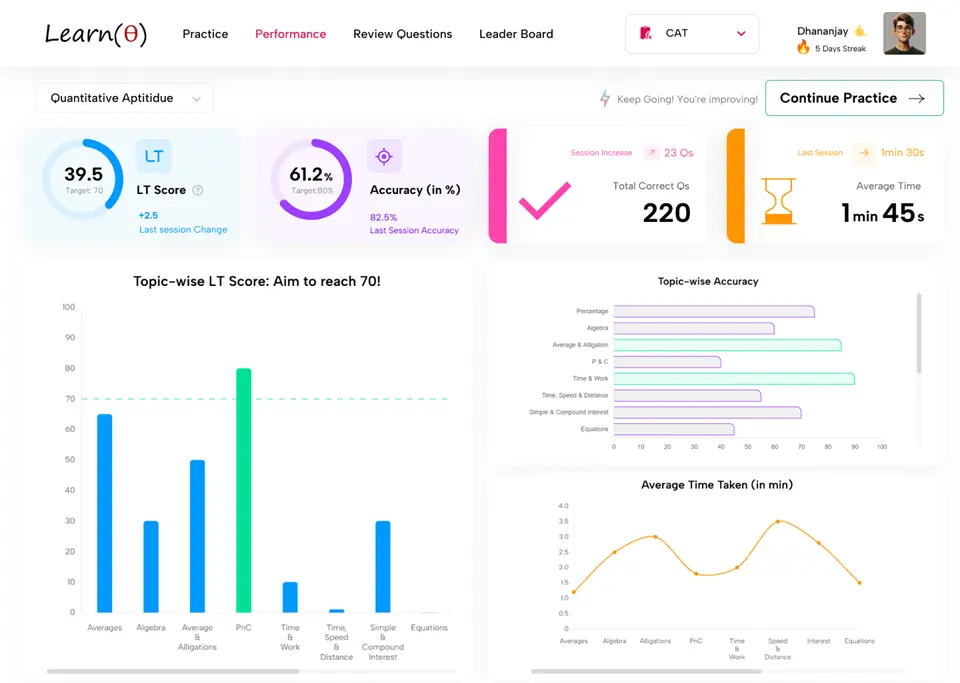Adobe – Aptitude Questions & Answers for Placement Tests
Reviewing Previous Year Questions is a good start. Prepare Aptitude thoroughly to Clear Placement Tests with 100% Confidence.
Q.1 A group of 10 pirates finds a treasure chest filled with gold coins. They decide to divide the coins in a specific manner. First, 9 pirates eat one pirate. Then the remaining 9 pirates eat one pirate. This continues until only one pirate remains. If it takes a pirate 2 hours to consume another pirate, how long does it take for only one pirate to be left?
Check Solution
Ans: B
The process involves 9 rounds of cannibalism initially, then 8 rounds, and so on until only one pirate is left. In each round, one pirate is eaten. It takes 2 hours per cannibalization. Round 1: 9 pirates eat 1 pirate (10 – 9 – 1 = 0 pirates eaten; 10 – 1 = 9 remaining) Round 2: 8 pirates eat 1 pirate (9-8-1=0 pirates eaten; 9-1 = 8 remaining) Round 3: 7 pirates eat 1 pirate (8-7-1=0 pirates eaten; 8-1 = 7 remaining) Round 4: 6 pirates eat 1 pirate (7-6-1=0 pirates eaten; 7-1 = 6 remaining) Round 5: 5 pirates eat 1 pirate (6-5-1=0 pirates eaten; 6-1 = 5 remaining) Round 6: 4 pirates eat 1 pirate (5-4-1=0 pirates eaten; 5-1 = 4 remaining) Round 7: 3 pirates eat 1 pirate (4-3-1=0 pirates eaten; 4-1 = 3 remaining) Round 8: 2 pirates eat 1 pirate (3-2-1=0 pirates eaten; 3-1 = 2 remaining) Round 9: 1 pirate eats 1 pirate (2-1-1=0 pirates eaten; 2-1 = 1 remaining) There are 9 rounds of consumption to get from 10 to 1. The total time required is 9*2 = 18 hours.
Q.2 A shopkeeper bought two articles for Rs. 4000 each. He sold the first article at a profit of 15%. He sold the second article at a loss. If the overall profit or loss percentage is 5%, what is the selling price of the second article?
Check Solution
Ans: D
Total cost price = 4000 + 4000 = 8000. Overall selling price = 8000 + 5% of 8000 = 8000 + 400 = 8400. Selling price of first article = 4000 + 15% of 4000 = 4000 + 600 = 4600. Selling price of second article = 8400 – 4600 = 3800.
Q.3 In triangle PQR, line ST is parallel to side QR. If PS = 4, SQ = 8, and the area of triangle PST is 10 square units, what is the area of quadrilateral STQR?
Check Solution
Ans: A
Since ST || QR, triangles PST and PQR are similar. The ratio of their corresponding sides is PS/PQ = 4/(4+8) = 1/3. The ratio of their areas is (1/3)^2 = 1/9. Therefore, if the area of triangle PST is 10, the area of triangle PQR is 9 * 10 = 90. The area of quadrilateral STQR is the difference between the areas of triangle PQR and triangle PST, which is 90 – 10 = 80.
Q.4 In a race, X gives Y a head start of 10 meters and Z a head start of 20 meters. Y gives Z a head start of 12 meters. If X, Y, and Z run at constant speeds, what is the total distance covered by all three runners in a race where X finishes first?
Check Solution
Ans: D
The question provides insufficient information about the total race distance or the relative speeds of the runners to calculate a concrete distance covered by all the runners.
Q.5 For what values of ‘m’ does the quadratic equation x2 + (m – 1)x + 1 = 0 have no real roots?
Check Solution
Ans: B
For a quadratic equation ax2 + bx + c = 0 to have no real roots, the discriminant (b2 – 4ac) must be negative. In this case, (m-1)2 – 4(1)(1) < 0. This simplifies to m2 - 2m - 3 < 0, which factors to (m-3)(m+1) < 0. The solution to this inequality is -1 < m < 3.
Q.6 A circle is inscribed in a square S1. Another square S2 is inscribed in the same circle. What is the ratio of the area of square S1 to the area of square S2?
Check Solution
Ans: B
Let the side of square S1 be ‘a’. The diameter of the circle is equal to the side of S1, so the radius of the circle is a/2. The diagonal of square S2 is equal to the diameter of the circle which is ‘a’. Let the side of S2 be ‘b’. By Pythagoras theorem, b^2 + b^2 = a^2 => 2b^2 = a^2 => b^2 = a^2/2. Area of S1 is a^2. Area of S2 is b^2 = a^2/2. Ratio of area of S1 to S2 is a^2 / (a^2/2) = 2/1.
Q.7 A vessel contains 60 liters of milk. 12 liters of milk are taken out and replaced with water. This process is repeated two more times. What is the quantity of milk left in the vessel now?
Check Solution
Ans: B
After the first replacement, milk left = 60 – 12 = 48 liters. Fraction of milk = 48/60 = 4/5. After the second replacement, milk left = 48 * (4/5) + 12 * (1/5) = 38.4 + 2.4 = 40.8 liters After the third replacement, milk left = 40.8 * (4/5) = 32.64 liters Another approach: Milk left after 3 replacements = 60 * (4/5) * (4/5) * (4/5) = 3072/125 = 38.4 liters
Q.8 A shopkeeper sells two articles for Rs. 9,600 each. On the first article, he makes a profit of 25%. On the second article, he incurs a loss. If the shopkeeper has neither profit nor loss in the entire transaction, then what is the percentage loss on the second article?
Check Solution
Ans: C
Cost price of first article = 9600 / 1.25 = 7680 Total selling price = 9600 * 2 = 19200 Total cost price = 19200 Cost price of second article = 19200 – 7680 = 11520 Loss on second article = 11520 – 9600 = 1920 Percentage loss = (1920 / 11520) * 100 = 16.67% (approx)
Next: Agilent Aptitude Questions
Refer Company wise Aptitude Questions
Practice 1000s of Aptitude Questions with Answers for Quant, Reasoning & Verbal
Fastest Way to Crack Aptitude Tests – LearnTheta’s AI-Practice!

✅ All Topics at One Place

🤖 Adaptive Question Practice

📊 Progress and Insights